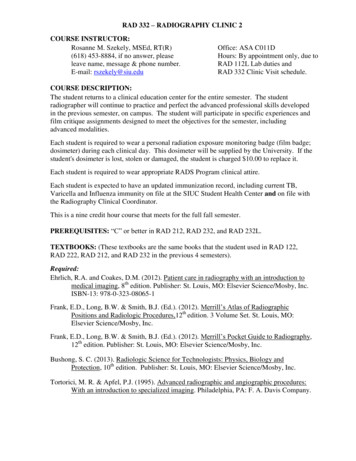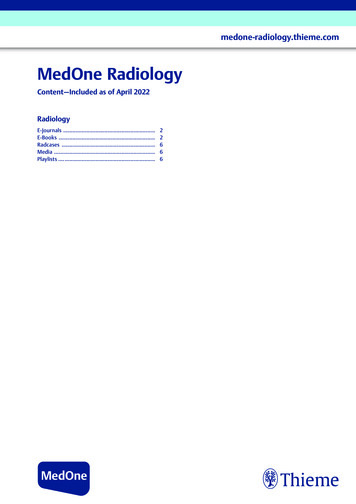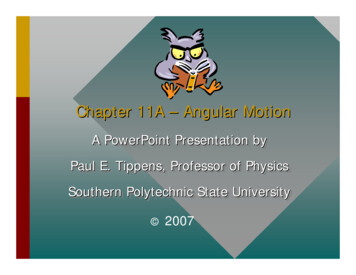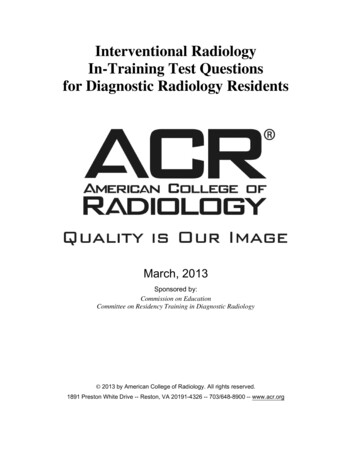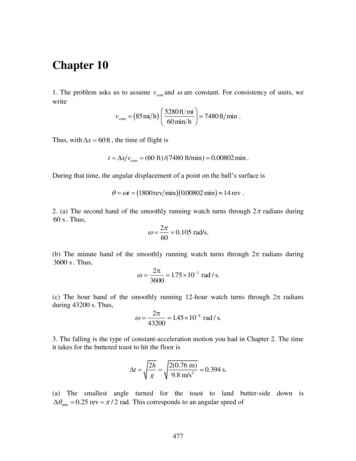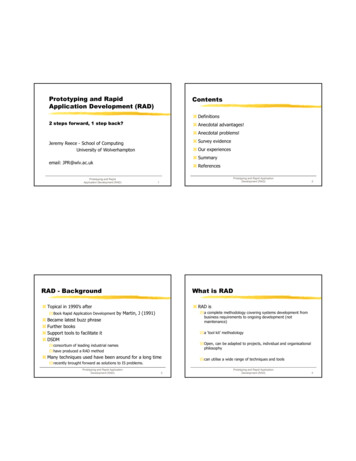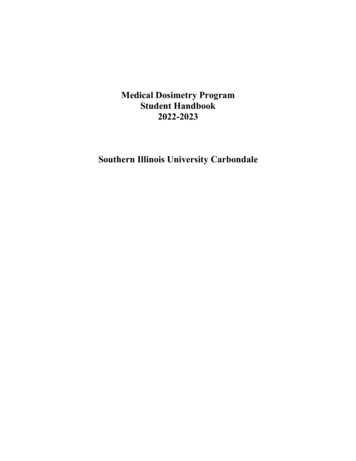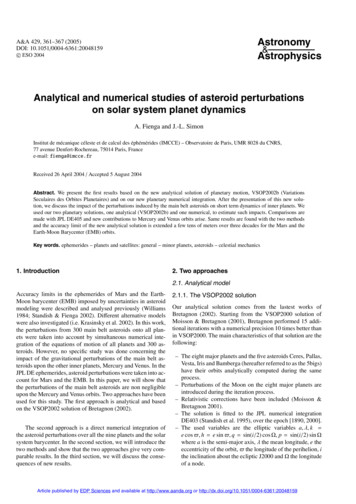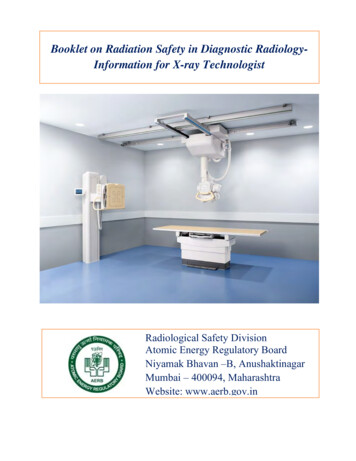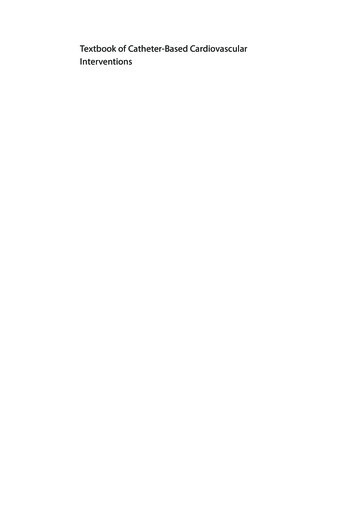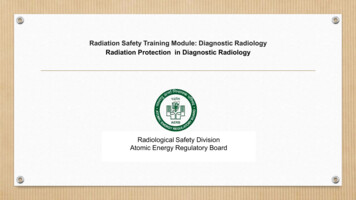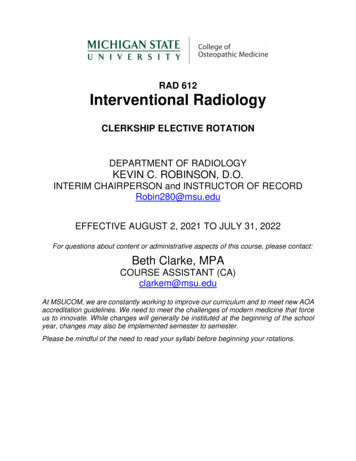
Transcription
RAD 612Interventional RadiologyCLERKSHIP ELECTIVE ROTATIONDEPARTMENT OF RADIOLOGYKEVIN C. ROBINSON, D.O.INTERIM CHAIRPERSON and INSTRUCTOR OF RECORDRobin280@msu.eduEFFECTIVE AUGUST 2, 2021 TO JULY 31, 2022For questions about content or administrative aspects of this course, please contact:Beth Clarke, MPACOURSE ASSISTANT (CA)clarkem@msu.eduAt MSUCOM, we are constantly working to improve our curriculum and to meet new AOAaccreditation guidelines. We need to meet the challenges of modern medicine that forceus to innovate. While changes will generally be instituted at the beginning of the schoolyear, changes may also be implemented semester to semester.Please be mindful of the need to read your syllabi before beginning your rotations.
TABLE OF CONTENTSINTRODUCTION AND OVERVIEW . 1ELECTIVE COURSE SCHEDULING . 1Preapproval . 1Required Prerequisites . 1Course Confirmation and Enrollment . 1ROTATION FORMAT . 1GOALS AND OBJECTIVES . 1EDUCATIONAL PURPOSE AND GOALS. 1Principal Teaching Methods . 2Educational Content . 2Principal Ancillary Educational Materials . 3Methods of Evaluation . 3Testing and evaluation . 3Rotation Specific Competency Objectives. 4COLLEGE PROGRAM OBJECTIVES. 4ROTATION REQUIREMENTS . 5ROTATION EVALUATIONS . 5Attending Evaluation of Student . 5Student Evaluation of Clerkship Rotation . 6Unsatisfactory Clinical Performance . 6CORRECTIVE ACTION PROCESS . 6BASE HOSPITAL REQUIREMENTS . 6STUDENT RESPONSIBILITIES AND EXPECTATIONS. 6MSU COLLEGE OF OSTEOPATHIC MEDICINE STANDARD POLICIES . 7ATTENDANCE POLICY . 7POLICY FOR MEDICAL STUDENT SUPERVISION .10Supervisors of the Medical Students in the Clinical Setting. 10Level of Supervision/Responsibilities. 10STATEMENT OF PROFESSIONALISM .11STUDENT RIGHTS AND RESPONSIBILTIES .11MSU Email . 11FACULTY RESPONSIBILITES .12COURSE GRADES .12N Grade Policy . 12STUDENT EXPOSURE PROCEDURE .12STUDENT VISA .12
RAD 612SUMMARY OF GRADING REQUIREMENTS . 14
RAD 612INTRODUCTION AND OVERVIEWELECTIVE COURSE SCHEDULINGPreapprovalo This course does not require preapproval from the IOR. The student shouldfollow the below directions for elective course confirmation and enrollment.Required Prerequisiteso This course requires the following prerequisite course(s): RAD 609Course Confirmation and Enrollmento The student must be an active student at Michigan State University College ofOsteopathic Medicine (MSUCOM).o Student must complete five core rotations prior to any elective rotation.o The student must receive MSUCOM confirmation and enrollment prior tobeginning any elective rotation. Once the student receives rotation acceptance from the host site,students must provide the elective application and host site approval toCOM.Clerkship@msu.edu for MSUCOM confirmation and scheduling. MSUCOM confirmation and enrollment is complete when the rotationis visible on the student’s schedule. MSUCOM confirmation must occur at least 30 days in advance of therotation.ROTATION FORMATThis course is designed to provide the student with an opportunity to actively engagein patient-based, learning experiences under the guidance of a faculty member(preceptor) in collaboration, as appropriate, with residents and/or fellows.Rotations are typically two weeks, 3 credit hours or four weeks, 6 credit hours induration. Timeframes for each rotation are decided at least 30 days prior to the beginningof the rotation.The overall performance of course participants will be evaluated through customaryassessment instruments normally employed by the department for core rotations, at thediscretion of the instructor of record.GOALS AND OBJECTIVESEDUCATIONAL PURPOSE AND GOALSInterventional Radiology (IR) is a branch of medicine that diagnoses and treats a varietyof disease throughout the body using percutaneous methods guided by radiologicimaging. The unique clinical and invasive nature of practice in vascular andinterventional radiology requires special training and specific skills. The purpose of thisrotation is to familiarize the student with the signs and symptoms of disorders amenable to1
RAD 612diagnosis and/or treatment by interventional radiology techniques. The significance of thesymptoms must be understood as well as the pathophysiology and natural history of thedisorders. The student will be exposed to the indications for and contraindications to basicvascular and interventional procedures, and will observe the clinical and technical aspects ofimplementation. They will gain a basic understanding of clinical evaluation and follow up,imaging methods, including percutaneous image guided procedures, and the fundamentals ofradiation physics, radiation biology, and radiation worker and patient protection.Principal Teaching Methods1. Students will rotate in the designated radiology department for the designatedtime of the rotation.2. Student will shadow resident and attending radiologists within interventionalradiology. There may be a pre-test and a post-test to document learning.The student will also be required to prepare and present a 5 to 10-minutePowerPoint presentation on an agreed upon topic, generally an interestingcase encountered during the rotation.3. Students will be expected to attend the various conferences and didacticlectures provided by the department (i.e. Grand Rounds, Tumor Board, CPC,M&M Conference, etc.) They will also attend interdepartmental conferencesinvolving radiology. They will be required to sign in at daily conferences todocument attendance.4. Rotation Directors will complete all evaluations at the end of the rotation.Educational Content1. Mix of diseases: The disease mix includes all patients, inpatient andoutpatient, who are undergoing interventional radiology procedures.2. Patient characteristics: Radiology cases include both outpatient and inpatientcases as determined by the patient mix at the host department. Demographicand ethnic mix approximates that of the local community. The extensivesocioeconomic diversity of the various participating institutions and patientpopulations support a stimulating training experience with broad diagnosticchallenges.3. Learning venues: Each of the participating radiology departments provides astimulating and balanced exposure to the patients in that community.4. Procedures: The types of radiological examinations and procedures availablefor observation include: Angiography Angioplasty and stent Venography Venous Access Biliary Drainage Nephrostomy Abscess Drainage Percutaneous Biopsy Embolization Percutaneous spine intervention (if available) Pain management (if available)5. Ancillary individuals interacted with may include residents, fellows,2
RAD 612technologists, and staff.6. Duration: The rotation is intended for a 2- 4 week block.7. Structure: The day typically begins at 7:00 a.m. and ends at 4:00 p.m. Most of8. the day will be spent in the reading room and procedural suites. Independentstudy using departmental and web resources may be permitted during theafternoons.A schedule of daily assignments will include at minimum:Clinical time 5 days a week.Reading educational materials with daily assignments.Attend hospital and department conference including interdisciplinary andradiology specific conferences.Students are expected to continue to attend any mandatory conferencesand didactic sessions of their college during the rotation.Principal Ancillary Educational Materials1. Textbooks from which selected reading are assigned: Vascular and Interventional Radiology: The Requisites, Second Edition byJohn Kaufman and Michael Lee. Vascular and Interventional Imaging: Case Review Series, Third Editionby Saad, Khaja & Vedantham. Atlas of Vascular Anatomy, Second Edition by Renan Uflacker Abrams’ Angiography: Interventional Radiology, Third Edition byGeschwind and Dake Vascular and Interventional Radiology, Second Edition by Karim Valji Introduction to Vascular Ultrasonography, Fifth Edition by Zwiebel andPellerito Handbook of Interventional Radiologic Procedures, Fifth Edition byKandarpa, Machan and Durham Teaching Atlas of Interventional Radiology: Non-Vascular InterventionalProcedures (Teaching Atlas Series), First Edition by Saadoon Kadir2. Textbooks, current radiology periodicals, and digital teaching series will beavailable in the onsite Radiology library and may vary somewhat by site.3. Full service, extended hour, libraries are present at Michigan State Universitywith onsite medical librarians, web-based searchable medical databases, andstandard medical journals in both print and electronic formats. In addition, allMSU students have 24-hour access to the extensive online Michigan StateUniversity electronic library, including databases and electronic journals.Methods of EvaluationThe radiologist supervising student education at each host department completesstandard evaluations in place for the clerkship rotations.Testing and evaluationIt is highly recommended that a radiology related PowerPoint presentation bepresented as appropriate at the host department and submitted to the MSU RadiologyDepartment education coordinator for review.3
RAD 612Rotation Specific Competency Objectives1. Become familiar with the appropriateness of patient selection for a requestedbasic procedure through review of available history, imaging, laboratoryvalues and proposed/expected outcomes of the procedure.2. Have a basic understanding of history/physical findings or treatmentscenarios that would require pre-procedure assistance from other specialtydisciplines such as cardiology, anesthesia, surgery and internal medicine.3. Have observed the informed consent process, after a review with the patientof the procedure(s), risks, benefits and alternative therapeuticoptions/procedures. Additionally, will have observed and practiced the preprocedure physician exam and evaluation.4. Have a basic understanding of the abnormalities and physicalsigns/symptoms that need immediate attention during a procedure.5. Have a basic understanding of percutaneous access selection forbiopsies/drainages for multiple imaging modalities.6. Have a basic understanding of vascular access for devise placement as wellas endovascular intervention.7. Have introductory knowledge of endovascular therapies and indications.8. Have introductory knowledge of equipment available for and indicated forinterventions (i.e. catheters, guidewires, embolization materials, etc.).9. Have observed post procedure recover and patient management.10. Have an understanding for follow-up and indications for follow-up imaging.11. Have a basic understanding of certain pharmacological considerations in thissetting: Drug/contrast reactions Antibiotic therapy Conscious sedation Anesthesia/analgesia AnticoagulationCOLLEGE PROGRAM OBJECTIVESIn addition to the above course-specific goals and learning objectives, this clerkship rotation alsofacilitates student progress in attaining the College Program Objectives. Please refer to thecomplete list provided on the MSUCOM website (https://com.msu.edu/) and in the StudentHandbook.4
RAD 612ROTATION REQUIREMENTSDUE DATEREQUIREMENTSUBMISSION METHOD(Please referto D2L foractual duedates)Attending Evaluation of ClerkshipStudentCan be accessed via the “AttendingEvaluation” link in Kobiljak onlineschedule. Email completed evaluationto COM.Clerkship@msu.eduLast Day ofRotationStudent Evaluation of Clerkship RotationCan be accessed and submitted viathe “Student Evaluation” link in Kobiljakonline schedule.Last Day ofRotationIMPORTANT NOTE: The student will maintain an “Extended” (ET) grade until they have successfully completed allacademic and clinical requirements for the course.ROTATION EVALUATIONSAttending Evaluation of StudentStudents are responsible for assuring that his/her clinical supervisor receives theappropriate evaluation form. Forms can be accessed via the “Attending Evaluation”link in the student’s Kobiljak online Clerkship schedule.Students should actively seek feedback on his/her performance throughout thecourse of the clinical rotation. Students should also sit down and discuss the formalevaluation with the clinical supervisor.Students should keep a copy of the evaluation and leave the original with theMedical Education Office at the clinical training site where that office will review, sign,and forward the completed form to the COM Clerkship Team. Any evidence oftampering or modification while in the possession of the student will be considered“unprofessional behavior” and will be referred to the MSUCOM Spartan CommitteeClearinghouse for resolution, per MSUCOM’s Common Ground Framework forProfessional Conduct or to the Committee on Student Evaluation (COSE).Grades are held until all rotation requirements, including evaluation forms, arereceived. Be sure you are using the correct form.5
RAD 612Student Evaluation of Clerkship RotationStudents will submit their rotation evaluations electronically at the conclusion ofevery rotation by accessing their online evaluation system in student.htmlUnsatisfactory Clinical PerformanceThe Instructor of Record and/or the Assistant Dean for Clerkship Education willreview/investigate a student’s performance on a rotation when a concern is raised bythe supervisor(s), and when the Attending Evaluation of Clerkship Student containsany below expectation marks within the professionalism area, any unsatisfactorywritten comments, or a total of two or more below average marks on the evaluation.Professionalism concerns, as well as accolades, will also be referred to theMSUCOM Spartan Committee Clearinghouse for resolution, per MSUCOM’sCommon Ground Framework for Professional Conduct.CORRECTIVE ACTION PROCESSThere is no Corrective Action offered on this course. As determined by the Instructor ofRecord, the student will receive an N grade for the course if all assignments are notcompleted successfully by (the Tuesday) 2 days after the last day of rotation at11:59pm (with the exception of the Attending Evaluation). Additionally, a letter ofunprofessional behavior for late submission of assignments will be sent to the MSUCOMSpartan Community Clearinghouse.BASE HOSPITAL REQUIREMENTSStudents are responsible for completing all additional requirements set by thehospital/clinical site in which the student is completing the rotation. Students are notresponsible for reporting results of requirements outside the ones listed above to thecollege.STUDENT RESPONSIBILITIES AND EXPECTATIONSCourse participants will meet the preceptor on the first day of the rotation at a predeterminedlocation to be oriented to rotation hours, location(s), and expected duties and responsibilitieswhile on-service. The student will meet the following clinical responsibilities during this rotation:o Students are expected to function collaboratively on health care teams thatinclude health professionals from other disciplines in the provision of quality,patient-centered care.The student will meet the following academic responsibilities during this rotation:6
RAD 612ooStudents are expected to identify, access, interpret and apply medicalevidence contained in the scientific literature related to patients healthproblems.Students are expected to: assess their personal learning needs specific tothis clinical rotation, engage in deliberate, independent learning activities toaddress their gaps in knowledge, skills or attitudes; and solicit feedback anduse it on a daily basis to continuously improve their clinical practice.MSU COLLEGE OF OSTEOPATHIC MEDICINE STANDARD POLICIESThe following are standard MSUCOM policies across all Clerkship rotations.ATTENDANCE POLICYOVERVIEWMichigan State University College of Osteopathic Medicine (MSUCOM) requires studentparticipation in clerkship rotations and clinical activities with consistent attendance toacquire the skills and knowledge that are necessary for successful program completion.Students are expected to take minimal time off outside of vacations already appearing inschedules and should only request time off in the rare events and circumstancesoutlined below.Specific courses may have additional absence requirements from this general clerkshippolicy, and it is the student’s responsibility to adhere to these requirements according tothe respective course syllabus.GENERAL POLICY All absences from rotations must be excused absences obtained by completing theClerkship Program Excused Absence Request Form.o Appropriate signatures must be obtained from both the attending physician andthe student coordinator at the rotation site.o MSUCOM Assistant Dean for Clerkship Education must approve absences forprolonged illnesses, bereavement, research presentations/conferences, orabsences exceeding the maximum time off any one rotation.o Once appropriate approval signatures are obtained, forms should be maintainedfor your records in the event they are requested or required at a later date. Unexcused absences are absences taken without the proper completion of theClerkship Program Excused Absence Request Form, or absences outside of thoselisted in the Clerkship Attendance Policy. Unexcused absences are consideredunprofessional and will result in a report to the Spartan Community Clearing Houseand/or the MSUCOM Committee on Student Evaluation (COSE).7
RAD 612Length ofrotation4 weeksMaximum number ofdays off2 days2 weeks0 daysException forresidencyinterviews fromOctober toJanuary in Year 4onlyShould an absence exceed these limits, the studentis responsible for requesting additional days fromthe Assistant Dean for Clerkship Education via email(com.clerkship@msu.edu) prior to the absence.A fourth-year student may be absent a total of 4 days on any 4-week rotation,or 2 days on any 2-week rotation during the months of October-Januaryduring Year 4 for interview purposes only. If interview absences exceedthese totals, the student must request additional days off from the MSUCOMInstructor of Record (IOR) for the course/rotation by submitting a ClerkshipProgram Excused Absence Request Form to the Course Assistant (CA).Contact information for the IOR and CA are found on the first page of therespective MSUCOM course syllabus.8
RAD 612Absence TypePersonal DayQualificationsIllnessMedical/Dental appointmentsWedding, family graduations(additional reasons must be discussed withthe Asst Dean for Clerkship Education priorto request)Maximum numberof days off5 total days peryear(individual events mustcomply with the max of2 days off any 4-weekrotation)Jury DutyCourt documentation mustaccompany the Clerkship ProgramAbsence Request Form.Hospital-organizedcommunity eventsExample: Special OlympicPhysicalsN/A1 dayExaminationCOMLEX USA Level 2CE/USMLE Step 2CK/Canadian MCCEECOMAT/NBME shelf examinationsTime required tocomplete examResearch presentation on corerotationTravel andpresentation d Illness,Bereavement,Maternity LeaveDetailsVacations must be planned during allotted vacationtime in schedule. Vacations are not acceptablepersonal day absences.Jury duty, when obligated, is not considered apersonal day absenceThese events would be considered part of therotation and not a personal day absence.Required Approvalfrom Assistant Deanfor ClerkshipEducationNoYesNoNoStudents should be reporting to rotation before/afterexaminationWhile on required/core rotations, no excusedabsences for any professional meeting will beallowed unless the student is presenting research inwhich they have participated.NoYesRequired for request to Asst Dean for Clerkship Education;conference agenda, location, date of presentation, invitation, orconfirmation of presentation by conference staff, proposed datesof absence.Conference or researchpresentation while on an electiverotation3 days on a 4week electiverotationStudent must submit Clerkship Program ExcusedAbsence Request Form and copy of conferenceagenda to the Assistant Dean for ClerkshipEducation to attend one (1) professional meeting ona 4-week rotation. Students cannot miss rotationdays for a conference during a 2-week electiverotation.Medical related absence orbereavementTBDStudents-contact the Assistant Dean for ClerkshipEducation to discuss time off rotationsYesYes9
RAD 612POLICY FOR MEDICAL STUDENT SUPERVISIONSupervisors of the Medical Students in the Clinical SettingThe MSUCOM curriculum includes required clinical experiences in a variety ofclinical learning environments. The role of the student is to participate in patientcare in ways that are appropriate for the student’s level of training and experienceand to the clinical situation. The student’s clinical activities will be under thesupervision of licensed physicians. This supervising physician may delegate thesupervision of the medical student to a resident, fellow, or other qualifiedhealthcare provider, however, the supervising physician retains full responsibilityfor the supervision of the medical students assigned to the clinical rotation andmust ensure his/her designee(s) are prepared for their roles for supervision ofmedical students.The physician supervisor and his/her designee(s) must be members in goodstanding in their facilities and must have a license appropriate to his/her specialty ofpractice and be supervising the medical student within that scope of practice asdelineated by the credentialing body of the facility.Level of Supervision/ResponsibilitiesClinical supervision is designed to foster progressive responsibility as a studentprogresses through the curriculum, with the supervising physicians providing themedical student the opportunity to demonstrate progressive involvement in patientcare. MSUCOM students will be expected to follow clinical policies of the facilityregarding medical records and clinical care. Medical student participation in patienthistory/physical exam, critical data analysis, management, and procedures willinclude factors, but not limited to:o The student’s demonstrated abilityo The student's level of education and experienceo The learning objectives of the clinical experienceFirst and second year medical students will be directly supervised at all times(supervising physician or designee present or immediately available.)Third- and fourth-year medical students will be supervised at a level appropriate tothe clinical situation and student’s level of experience. For some tasks, indirectsupervision may be appropriate for some students. Direct supervision would beappropriate for advanced procedures.Supervising physicians will provide medical students with timely and specificfeedback on performance. The supervising physician will complete a mid-rotationevaluative discussion with the medical student. Supervising physicians willcomplete a summative evaluation and are encouraged to contact thecourse/clerkship director with any gaps in student performance.10
RAD 612Medical students with any concern regarding clinical, administrative, and educationalor safety issues during his/her rotation will be encouraged to contact the supervisingphysician or clerkship/course director.STATEMENT OF PROFESSIONALISMPrinciples of professionalism are not rules that specify behaviors but guidelines thatprovide direction in identifying appropriate conduct. These principles include the safetyand welfare of patients, competence in knowledge and skills, responsibility forconsequences of actions, professional communication, confidentiality, and lifelonglearning for maintenance of professional skills and judgments. Professionalism andprofessional ethics are terms that signify certain scholastic, interpersonal andbehavioral expectations. Among the characteristics included in this context is theknowledge, competence, demeanor, attitude, appearance, mannerisms, integrity, andmorals displayed by the student to faculty, peers, patients, and colleagues in otherhealth care professions.Students are expected to conduct themselves at all times in a professional manner and toexhibit characteristics of a professional student.STUDENT RIGHTS AND RESPONSIBILTIESEach individual student is responsible for their behavior and is expected to maintainstandards of academic honesty. Students share the responsibility with faculty forcreating an environment that supports academic honesty and principles ofprofessionalism. Proper relationship between faculty and student are fundamental tothe college's function and this should be built on mutual respect and understandingtogether with shared dedication to the education process. It is a fundamental beliefthat each student is worthy of trust and that each student has the right to live in anacademic environment that is free of injustice caused by dishonesty. While studentshave an obligation to assist their fellow students in meeting the common goals of theireducation, students have an equal obligation to maintain the highest standards ofpersonal integrity.MSU EmailTo facilitate communication from faculty and staff to students, students are requiredto have a functioning MSU email address. Students are responsible for checkingtheir MSU email accounts daily and maintaining their MSU mailboxes so thatmessages can be received.Forwarding MSU email to another email account or failure to check email are notvalid excuses for missing a deadline or other requirements of the clinical educationprogram.Further, students must use secure email when working in a hospital, clinic, or otherhealth care setting if discussion of patient information is involved. MSUNet (msu.edu)email is secure; many web-based email systems including Hotmail, Gmail and Yahooare not.11
RAD 612FACULTY RESPONSIBILITESIt is the responsibility of the college faculty to specify the limits of authorized aid(including but not limited to exams, study aids, internet resources and materials fromsenior students) in their syllabi, and it is the responsibility of students to honor andadhere to those limits. Course instructors shall inform students at the beginning of thesemester of any special criteria of academic honesty pertinent to the class or course.It is the responsibility of the clinical faculty to provide students with ongoing feedbackduring rotation upon request. Clinical faculty are generally recommended (though notrequired) to limit student assigned duty hours from 40 to 60 hours weekly (and notexceeding 60 hours). Both faculty and students are to be treated fairly and professionallyto maintain a proper working relationship between trainer and trainee.COURSE GRADESP/Pass –
Interventional Radiology (IR) is a branch of medicine that diagnoses and treats a variety of disease throughout the body using percutaneous methods guided by radiologic imaging. The unique clinical and invasive nature of practice in vascular and interventional radiology requires special training and specific skills. The purpose of this
